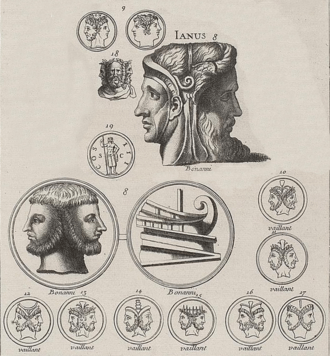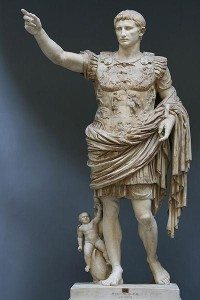Numa Pompilius
Gregorian Months
 The Gregorian Calendar (a solar calendar) was instituted in 1582 A.D. by Pope Gregory XIII as a reform to the Julian Calendar, which was instituted in 46 B.C. by Julius Caesar. However, the title Gregorian Months is a bit misleading; however, I felt that this title was appropriate for identification purposes, due to its familiarity. Nevertheless, the origination of the names of the months in our current calendar goes far beyond Pope Gregory, or even Julius Caesar. Roman legend attributes the discovery of the Roman civilization to Romulus, its first king (one of two brother who were apparently raised by wolves) who was also responsible for instituting their calendar. However, this calendar only consisted of ten “named” months (March through December), and the remaining two months of winter were simply disregarded. It wasn’t until around 753 BC when Numa Pompilius, Rome’s second king, that the two disregarded months were given names, hence the birthing of January and February. Though it appears that the names of the Roman months (aside from January and February) were accredited to Romulus, his actual existence (and seemingly his contributions) has been quite difficult to substantiate, hence earning the classification of “legendary.” With that being the case, I felt that it would appropriate and fitting to focus on and discuss Numa’s contribution. Also, please keep in mind that the months July (the fifth month) and August (the sixth month) were originally named Quintilis and Sextilis, respectively, and were renamed in honor of Julius Caesar (in 44 BC) and his great-nephew Caesar Augustus (between 26 – 23 BC) under the Julian Reform.
The Gregorian Calendar (a solar calendar) was instituted in 1582 A.D. by Pope Gregory XIII as a reform to the Julian Calendar, which was instituted in 46 B.C. by Julius Caesar. However, the title Gregorian Months is a bit misleading; however, I felt that this title was appropriate for identification purposes, due to its familiarity. Nevertheless, the origination of the names of the months in our current calendar goes far beyond Pope Gregory, or even Julius Caesar. Roman legend attributes the discovery of the Roman civilization to Romulus, its first king (one of two brother who were apparently raised by wolves) who was also responsible for instituting their calendar. However, this calendar only consisted of ten “named” months (March through December), and the remaining two months of winter were simply disregarded. It wasn’t until around 753 BC when Numa Pompilius, Rome’s second king, that the two disregarded months were given names, hence the birthing of January and February. Though it appears that the names of the Roman months (aside from January and February) were accredited to Romulus, his actual existence (and seemingly his contributions) has been quite difficult to substantiate, hence earning the classification of “legendary.” With that being the case, I felt that it would appropriate and fitting to focus on and discuss Numa’s contribution. Also, please keep in mind that the months July (the fifth month) and August (the sixth month) were originally named Quintilis and Sextilis, respectively, and were renamed in honor of Julius Caesar (in 44 BC) and his great-nephew Caesar Augustus (between 26 – 23 BC) under the Julian Reform.



